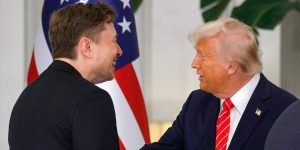The relationship between Elon Musk and Donald Trump has been anything but predictable, marked by periods of alignment, sharp disagreement, and recent reconciliation. From initial skepticism to enthusiastic support, and then back to public criticism, the dynamic between the world’s richest person and the former U.S. president has captivated observers worldwide. This article delves into the complex history of the Elon Musk and Donald Trump relationship, charting its evolution from 2016 to the present day, including the surprising turn of events in 2024 and 2025.
Initial Friction: 2016 – 2017
Initially, Elon Musk voiced concerns about Donald Trump’s suitability for the presidency. Just prior to the 2016 election, Musk publicly stated to CNBC that he didn’t believe Trump should be president, citing concerns about his character and its reflection on the United States. He even expressed a preference for Hillary Clinton’s policies, highlighting their appeal in areas like economics and environmental protection.
However, following Trump’s victory, a surprising shift occurred. Despite his initial reservations, Musk accepted appointments to two of Trump’s economic advisory councils, alongside other prominent business leaders like Travis Kalanick, the then-CEO of Uber. This move drew criticism, but Musk defended his decision, stating he aimed to influence policies regarding environmental issues and immigration from within the administration.
This period of collaboration proved short-lived. In June 2017, Musk resigned from these advisory roles in protest of Trump’s decision to withdraw the US from the Paris Agreement on climate change. He took to Twitter, declaring that leaving the agreement was detrimental to both America and the world. This underscored the core difference between the two men: Musk’s commitment to sustainable energy initiatives like Tesla and solar power directly clashed with Trump’s energy policies.
A Budding Alliance & Political Entanglements: 2020-2022
The relationship saw a resurgence in 2020. Trump publicly praised Musk’s accomplishments, referring to him as “one of our great geniuses” and drawing parallels to historical innovators like Thomas Edison. He voiced support for Musk during a dispute with California authorities over Tesla factory closures during the COVID-19 pandemic, even tweeting directly in Musk’s defense. This period marked a turning point, with increasing public alignment between the two figures.
Musk further signaled a willingness to engage with the Trump orbit by announcing in 2022 that he would reinstate Trump’s Twitter account, having acquired the platform. He characterized the original ban as a “morally bad decision,” emphasizing his commitment to “free speech absolutism.” This decision fuelled further speculation about the evolving dynamic between the two billionaires.
However, tensions quickly resurfaced. In July 2022, Trump publicly questioned Musk’s political allegiances, accusing him of falsely claiming to have voted for him. Musk swiftly refuted this claim on Twitter. Soon after, Musk publicly urged Trump not to run for reelection, suggesting he should “hang up his hat” and even suggesting an age limit for presidential candidates, a clear jab at Trump’s age.
From Feud to Reconciliation: 2024-2025 and Beyond
The conflict escalated in the summer of 2022. Trump launched a scathing attack on Musk, criticizing his companies and questioning his financial dependency on government subsidies. Musk responded with characteristic brevity on Twitter (“Lmaooo”). Despite this, Trump applauded Musk’s acquisition of Twitter in October 2022, though he reiterated his preference for Truth Social.
The political landscape shifted dramatically in 2024. As Trump campaigned for reelection, he actively sought Musk’s support. While initially hesitant to contribute financially, Musk endorsed Trump following an attempt on Trump’s life during a rally. He even reportedly pressed Trump to choose Ohio Senator JD Vance as his running mate, a suggestion which Trump ultimately followed.
This endorsement led to increased public appearances together. Musk joined Trump on stage at a rally in Pennsylvania, publicly supporting his candidacy and suggesting that Trump’s victory was crucial for preserving the Constitution and democracy. This culminated in Trump winning the presidency in November 2024, with Musk playing a significant role in his campaign.
Following the election, Trump announced the creation of a Department of Government Efficiency (DOGE), with Musk at its helm. While the extent of Musk’s authority within the administration was debated, he became a prominent figure in the new administration, even sparking speculation about a potential cabinet position. This alignment, however, wasn’t without its challenges, as Musk eventually stepped back from DOGE following disagreements over Trump’s “Big Beautiful Bill,” a spending proposal he deemed fiscally irresponsible.
Despite further public disagreements and a temporary falling out, culminating in Musk even considering launching a third political party, the two have appeared to reconcile. Their recent reunion at a memorial service and Trump’s subsequent positive statements suggest a restored, if complex, relationship. This ongoing saga between Elon Musk and Donald Trump demonstrates the unpredictable nature of political alliances and the powerful influence of individuals in today’s world, showcasing dynamic shifts in political endorsements and US politics. This unique partnership continues to generate considerable media attention and shapes the discourse surrounding future governance.


